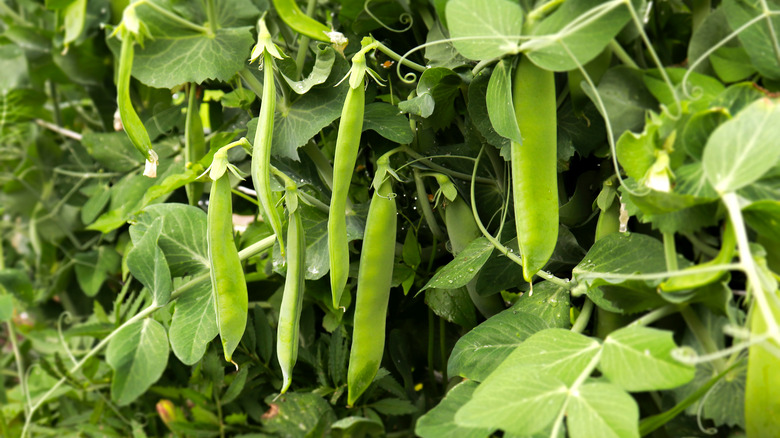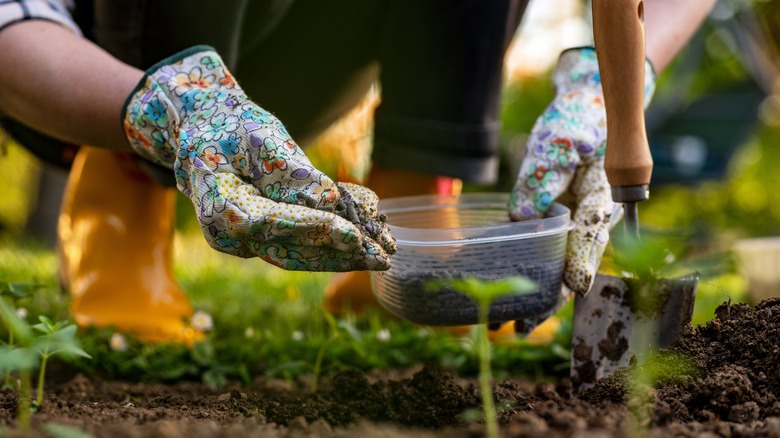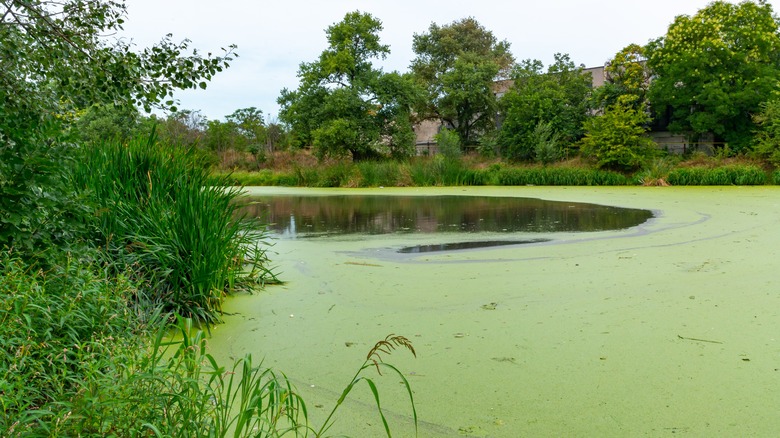How To Grow More Fruitful Pea Pods With The Help Of This Fertilizer
If you've been lucky enough to snack on sun-warmed pea pods right off the vine, you can't forget the crisp crunch of the pod and the succulent pop of the peas inside as you bite into it. Fresh peas straight from the garden are a summer luxury, and luckily for us, they are resilient and relatively easy to grow in most parts of the U.S. This tasty, cold-hardy vegetable doesn't need much fertilizer at all. With so many winning qualities, you might wonder if you need to do anything more than simply plant the seeds, water, and wait. Make the most of your hard work in the soil by setting up your seedlings with a bit of phosphorus fertilizer. This nutrient may bring you bushels of sweet pods to savor.
Peas thrive on phosphorus, so you will definitely want to include it in your pea patch. Yet, too much of this nutrient can be a bad thing. Start your quest for a bountiful harvest with a soil test. If your garden could use a phosphorus boost, there are some natural and conventional fertilizer options for you. However, it's crucial be cautious when applying this nutrient.
When and how to give your peas a phosphorus boost
Before committing to amending your peas with phosphorus, test the health of your soil. If your garden isn't short on this element, use a fertilizer mix that's low in phosphorus or one that doesn't contain any. If your test shows that the soil does need a dose of the stuff, you have conventional and natural formulas to choose from.
For the conventional route, opt for a 5-10-10 fertilizer (The numbers correspond to how the percentages of nitrogen, phosphorus, and potassium, in that order, are in the fertilizer mix.) Don't purchase a fertilizer that contains weed killer, as that will harm your peas. Choose a natural fertilizer to nourish your garden with phosphorus. Consider natural/organic phosphorus sources such as bone meal, bat guano, and colloidal phosphate (a dust made from rocks).
It's only necessary to fertilize peas with phosphorus before planting and while the vines are in bloom. Add about 2 ounces of 5-10-10 fertilizer for a 5-foot by 5-foot plot. Mix this into the top 3 to 4 inches of soil one or two days before you plant. There isn't much information available about the exact amounts of homemade fertilizer you should apply. You may want to mix in a conservative sprinkling with the top few inches of soil, and then repeat the phosphorus test to prevent excess phosphorus from entering waterways.
Why too much phosphorus is a problem
Fertilizers are only helpful when they're contributing to the growth and health of your plants. More is most certainly not always better. In order to keep our ecosystems healthy, it's crucial to pay close attention to the amount of phosphorus you put into our garden soil. Soil runoff that's laced with excess phosphorus wreaks havoc on waterways. The growth-enhancing effects we love for vegetables can take over in ponds, streams, lakes, and more. Unwanted algae and aquatic plants get a shot of nutrients from the runoff. This can be disastrous for animals who live in those habitats. Phosphorus is enough of a threat that lawn fertilizers containing this element have been banned in some states.
Plus, too much phosphorus will also harm what you are trying to help grow. It can kill your carefully tended pea pods and other plants. Toxic levels of phosphorus build up in plants if there is too much for them to process. A visible sign of toxicity from this nutrient is color changes in the leaves. Look for discoloration between leaf veins.


